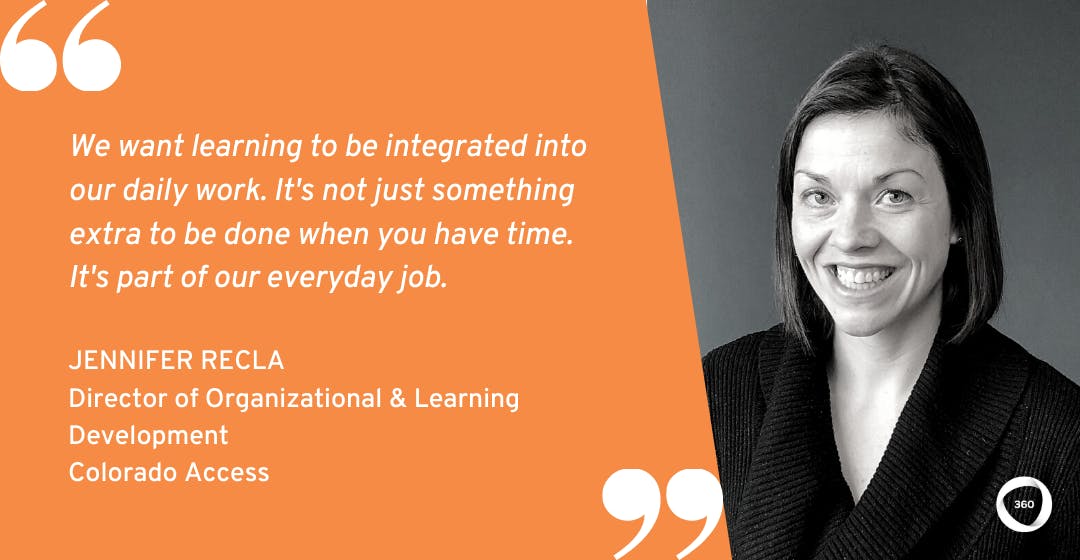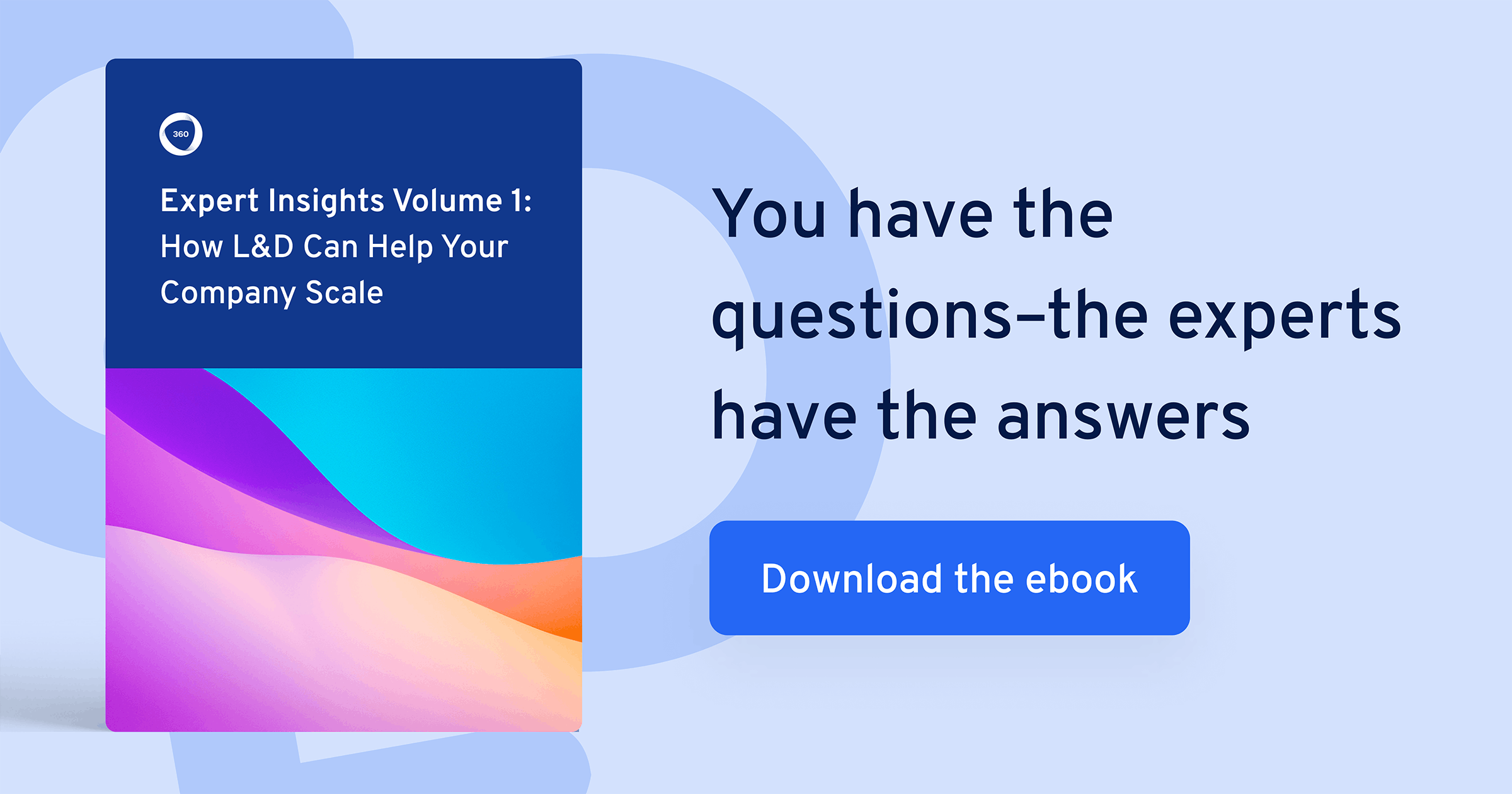When you think of innovation in healthcare, you probably picture doctors and technicians in pristine white coats, fine-tuning the next world-changing medical breakthrough in the lab.
Another key part of healthcare innovation? Supporting healthcare providers with the right development programs, professional training opportunities, and learning culture. This L&D support is critical, as it helps providers to deliver better outcomes for patients and clients.
Recently, I sat down with Jennifer Recla, Director of Organizational & Learning Development at nonprofit health plan Colorado Access. We talked about how strategic L&D programs can support a culture of innovation, and her commitment to a safe and open employee culture.
We got started by discussing the history and aspirations of Colorado Access.
Colorado Access: Colorado’s largest public-sector health plan
As Jennifer explains, Colorado Access has a big presence in Colorado–and a big job to do.
“Colorado Access is the largest public sector health plan in the state of Colorado,” she says. “We’re a non-profit organization, and we’ve been working for about 25 years now. We’re focused not just on providing access to care, but advancing meaningful and measurable improvements in the way healthcare is delivered to better the lives of our members.”
“I’ve been working at Colorado Access for almost two years. Our focus in the Organizational and Learning Development team is really to provide a holistic approach to learning. We want learning to be integrated into our daily work. It’s not just something extra to be done when you have time. It’s part of our everyday job.”
This focus includes an emphasis on creating informal opportunities for learning, as well as formal ones. “We want people to think about learning beyond the classroom, and beyond just on-demand and online learning,” says Jennifer. “It could be in conversations like the one we’re having right now, because there are always ways to learn from others.”
“I have a great team that supports this holistic approach. There are five of us in total, and we help support about 375 employees.”
Need a few more CLO Connect expert insights? Find out How L&D Can Help Your Company Scale
The challenges of a single-customer business model
As Jennifer explains, Colorado Access’s unique single-customer business model does give rise to some unique considerations for her L&D team–and one significant challenge.
“The state of Colorado is our customer, and we are a contract-based organization,” says Jennifer. “We really have one big contract, and it’s about to expire in a few years. The challenge for us is, how do we position ourselves so that the state wants to continue with us, and renew our contract? And how do we give people with the right learning support to achieve this?”
Adding to this challenge is the constantly changing nature of the healthcare sector. “The healthcare landscape is always evolving. We need to be nimble and agile, especially in the current public health crisis around COVID-19. This crisis has had a major impact on our work.”
So, how are Jennifer and her team responding to this challenge? “We’re really focused on updating our strategic plan and our strategic goals,” she says. “We want to position ourselves to continue to deliver excellent care to our members, and to continue innovating.”
Related: How Medical Dermatology Firm Dermira Keeps Engagement High During COVID-19
The challenge for us is, how do we position ourselves so that the state wants to continue with us and renew our contract? And how do we give people with the right learning support to achieve this?
The 4 priorities informing Colorado Access’s learning strategy
“Right now, we have four strategic priority areas informing our learning strategy,” says Jennifer. “These are health transformation, operational excellence, financial stability, and culture.”
“As we’re building strategic goals within each of these priorities, we’re also looking at the themes within these goals. We want to know what professional and leadership skills we need as an organization to be successful. What’s the current state of those skills? And where can we build additional proficiencies?”
“We do an internal learning needs assessment every year to gauge our needs and establish our competencies in different areas. For example, we want to continue to build our culture of innovation. Our employees are telling us that they’re not as proficient in that area as they’d like to be, and they need some assistance. So we’re building learning interventions around that.”
“Our team also plays a large part in the culture piece,” says Jennifer. “We’re thinking through whether our culture supports our strategic priorities and goals. Are we aligned with the mission and vision values? Are we aligned with the learning needs of the organization?”
We want to continue to build our culture of innovation. Our employees are telling us that they’re not as proficient in that area as they’d like to be, and they need some assistance. So we’re building learning interventions around that.
Colorado Access’s 3 L&D programs supporting innovation
As part of its wider learning strategy, Colorado Access has three active programs aimed at supporting this focus on innovation and preparing the organization for the contract renewal process: a Leadership Academy, action learning projects, and collaborative social learning.
“We want to make sure we’re cultivating learning opportunities that align with these priority areas and help to move us forward, especially around innovation,” says Jennifer. “That’s why we’ve rolled out a number of initiatives within our learning strategy to help us with these goals.”
1. Leadership Academy
“One of our initiatives is our Leadership Academy program,” says Jennifer. “This is a cohort of managers and directors, and it’s undertaken in partnership with the University of Denver. There’s a formal learning component in that, and an experiential learning component too.”
“Our focus with the Leadership Academy is really about building relationships and trust within that group, and creating the right connections between people.”
2. Action learning projects
“We also have our action learning projects. These align with our strategic priorities, and we help support them afterwards with informal opportunities to connect with alumni in a social setting. Sometimes it’s about learning, and sometimes it’s about building relationships.”
On top of these action learning projects, Jennifer and her team also tailor additional support on a team-by-team basis. “We provide a lot of support to specific departments, including a couple of learning and development specialists helping our customer service team.”
“We also have a specialist dedicated to our care management team, because they’re a direct line to our members. They really help our members navigate through Medicaid, which can be a very complex health plan.”

3. Collaborative social learning
“One more recent program is an opportunity for collaborative social learning,” says Jennifer. “We’re calling it Care Management Gathering, and it’s a chance for our newer care managers to get together. For the first half hour, they’ll be talking through their challenges: what are their major stresses, and what questions do they have about their role?”
“The second half is a dedicated topic, which could be something job-specific, or interpersonal or communication skills. It could be a guest speaker, or another leader in the organization coming and presenting. It’s still very much a discussion, and an informal learning opportunity.”
As Jennifer explains, her team has already had some success with this mix of informal discussion and dedicated topics. “It’s something we’ve already rolled out in other areas. We have a gathering specifically for our formal leaders, and a group that is dedicated to presentation and facilitation skills. This is in a more informal environment.”
“We have a group focused on crucial conversation skills, too. We’ve found that these informal discussions are a great chance to build relationships across the company, and to dig deeper into topics and focus on real-world situations. It’s immediately applicable for people.”
These three programs highlight the key role L&D teams have to play in creating spaces for people to experience Collaborative Learning. It isn’t always about designing learning experiences to fit a specific need: sometimes, we just need to create the right opportunities for people to talk about their experiences, share their expertise, and learn from each other.
Related: 5 Collaborative Learning Strategies to Incorporate Into Your Training Programs
We’ve found that these informal discussions are a great chance to build relationships across the company, and to dig deeper into topics and focus on real-world situations. It’s immediately applicable for people.
Creating an environment of psychological safety
Another key priority underpinning these strategic priorities, according to Jennifer? Creating an environment in which people feel comfortable to speak up and say what they really think.
“One thing I’m really focused on right now is psychological safety,” she says. “We want to create a culture where people feel comfortable speaking up and taking risks.”
“We’re really focused on our innovation value. The more research I do on skills related to innovation, the more I understand the importance of creating an environment where people feel comfortable admitting mistakes and looking at them as learning opportunities.”
For Jennifer, this sense of support is key for Colorado Access to deliver better outcomes for its members. “We want people to feel comfortable raising their hands and saying, ‘this doesn’t look right’. We want to build this foundation of psychological safety, because it’s so important for the innovation work that we do, and for the effectiveness of our teams.”
Related: The Learning Expert’s Guide to Sharing Effective Feedback
We’re really focused on our innovation value. The more research I do on skills related to innovation, the more I understand the importance of creating an environment where people feel comfortable admitting mistakes and looking at them as learning opportunities.
Measuring impact through learner feedback and engagement
Jennifer and her team have an ambitious set of strategic L&D programs underway. But how do they know these programs are creating the right impact?
“We collect feedback on all of our sessions, and it’s been really positive so far,” says Jennifer. “We have repeat participants, which is another great sign. Especially for the leaders gathering, people are coming back each month to follow up on the challenges they’re still experiencing.”
“Overall, we also look at our engagement scores, too. When I started, we were at a 57% favorable rating for skills and professional development, and we’re now at 77%. That shows what we’ve been able to offer with our program variety, and it shows that people are thinking beyond just formal training for their learning opportunities. That’s really exciting for us to see.”
Related: 3 Data-Based Ways to Prove Training ROI (+ Free Training ROI Calculator)
When I started, we were at a 57% favorable rating for skills and professional development, and we’re now at 77%. That’s really exciting for us to see.
For Jennifer, seeing people come back again and again isn’t just a vote of confidence; it also gives her the chance to build a deeper understanding of the issues people are facing. “As a learning team, we get the opportunity to explore the real issues our managers, directors, and supervisors are dealing with. It really helps to be able to dig deeper into the root causes.”
Thanks again to Jennifer for taking the time to share her insights with us!
While you’re here, check out my expert interviews with Adam Oppegaard of Tower Loan about his 3 key steps to impactful manager training, and with Sarah Cannistra of the Overnight Trainer podcast about how to balance learning against sales targets in real estate.
Want more peer insights on transforming workplace learning? Check out #CLOConnect, our interview series with top L&D leaders on driving growth and scaling culture through Collaborative Learning. Or you can subscribe (below 👇) to our weekly newsletter to receive our latest posts directly in your inbox.



